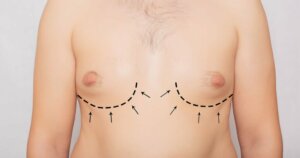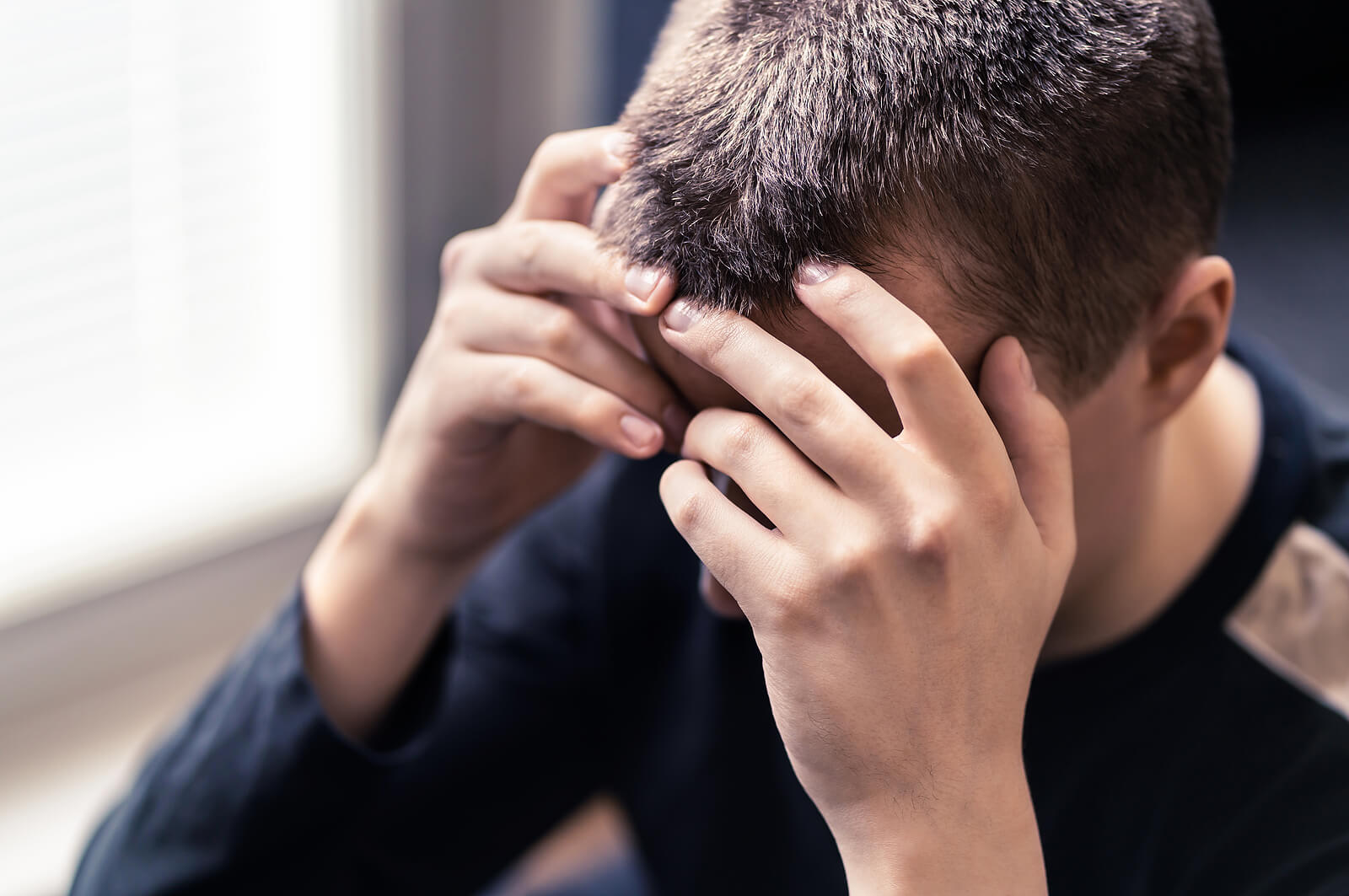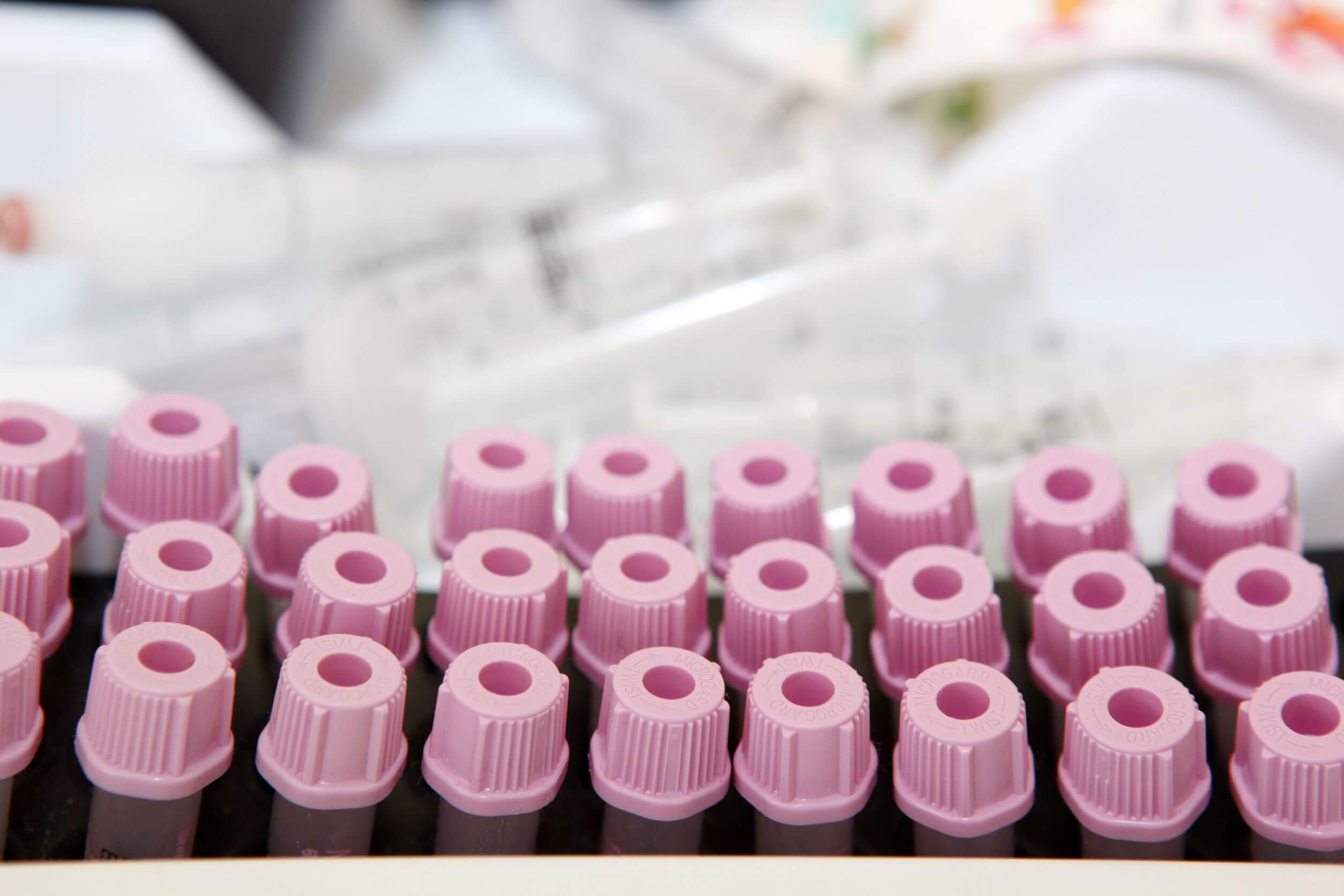Gynecomastia: Symptoms, Causes and Treatment

Both men and women have mammary glands. The difference is that in males they’re less developed and tend to be small. However, there’s a pathology that reverses this condition. It’s known as gynecomastia and is characterized by the increase in the volume of these glands.
What’s gynecomastia?

Gynecomastia is defined as the ‘enlargement of the mammary glands in men’. It can affect one or both breasts and usually occurs in older adults, adolescents, children, or newborns.
Many people have the belief that when a man has pronounced mammary glands, it can only be related to being overweight. However, this condition is known as pseudogynecomastia, and it’s very different from gynecomastia. Losing weight or having an intense exercise routine won’t solve the problem.
Many cases of gynecomastia don’t need treatment. However, it’s a condition that men feel not to be very aesthetic, and, as a result, it ends up affecting the self-esteem of those who suffer from it. Some specialists prescribe a specific treatment or even perform surgery.
What are the symptoms of gynecomastia?
If you’re a man and have any of these signs, it’s important that you go to see your doctor so that they can diagnose the cause of the condition:
- Swollen breasts
- Areolas that have increased in diameter
- Tender breasts, although most cases are usually painless
- Any type of secretion from the breast
What causes gynecomastia?
It’s usually associated with an increase in the hormone estrogen and a decrease in the hormone testosterone. As men grow or go through the different phases of life, they can suffer from hormonal fluctuations.
In andropause
In women, this stage is known as menopause, but in men when the production of male sex hormones decreases, we say that they are facing andropause. If the hormonal balance changes, a man can suffer from gynecomastia, as well as loss of sleep and hair.
In adolescence
It may be difficult to understand, but boys also produce female hormones, although to a lesser extent than male sex hormones.
When a boy goes through puberty, the balance is disturbed and more estrogens (female hormone) are produced than androgens (male hormone). This imbalance can lead to gynecomastia, although it usually disappears when hormone levels return to their normal levels.
According to a study published in the medical journal Seminars in Plastic Surgery, 10% of children who are undergoing puberty transformation suffer from gynecomastia.
In babies
When children are breastfed, the mother transfers some estrogen to them. This can alter the levels of this hormone in babies and cause gynecomastia.
According to a study published in American Family Physician, 1 in 9 newborn boys have noticeable breast tissue.
Narcotic substances
A study published in Canadian Family Physician revealed that drugs can also affect hormonal balance and cause estrogen levels to rise more than necessary. So, steroids and amphetamines can cause gynecomastia.
Other conditions
Some other rare conditions are associated with gynecomastia, and these are testicular tumors, chronic kidney failure, hyperthyroidism, and cirrhosis.
How is gynecomastia diagnosed?

The doctor often asks routine questions, such as your medical history or if there’s anyone in your family who has suffered from inflammation in the breasts. Also, at this point, your doctor will likely examine your genitals and breasts. Gynecomastia is considered to be possible when the breast tissue has increased by at least 0.5 centimeters (0.2 inches) in diameter.
Other tests to perform are blood tests, to evaluate hormone levels, and an ultrasound to look at breast tissue. They may also ask for an x-ray, biopsy, MRI or CT scan.
Risk factor’s
Experts suggest that between 10 and 20% of gynecomastia cases are due to the abuse of herbal medications and 25% are unknown. Some risk factors could be the following:
- Alcohol abuse
- Radiation treatment to the testicles
- Anabolic steroids
- Having kidney or liver disease
- Klinefelter syndrome
- Hyperthyroidism
- Tumors in the testicles
- Consuming certain antibiotics
- Chemotherapy
- Treatment for ulcers
- Certain HIV medications
- Consuming diazepam
Treatment for gynecomastia
If gynecomastia is caused by a medical condition, causes severe pain, or affects the patient’s self-esteem, then the doctor will usually proceed with surgery or prescribe treatment. However, you should bear in mind that in most cases this pathology disappears when hormonal levels return to normal.
Surgery
To remove much of the glandular tissue, the expert often suggests performing a mastectomy. This only happens when gynecomastia is psychologically affecting the person, to the point of diminishing their public or social relationships.
Medicines
In order to block estrogen, they often prescribe tamoxifen. This is often used in breast cancer patients, however, according to research published in the Clinical Trial, it may also relieve pain and inflammation in men with large breasts.
Another treatment that might be used is raloxifene. However, according to some studies, it may produce unfavorable results in aromatase inhibitors, drugs used to treat postmenopausal women and breast cancer.
Mental therapy
Gynecomastia can affect men psychologically, to such an extent that they withdraw from the social life they were used to. Attending support groups or a psychologist can help you find mental stability.
Gynecomastia, an aesthetic problem
Gynecomastia can affect men’s social life. The abnormal growth of their breasts can embarrass them to the point of withdrawing from their friends or the places they frequented.
In general, this condition can occur in infants, adolescents, and older adults when there’s an imbalance in the levels of male and female hormones.
However, the consumption of some drugs and medications can increase the risk, so you should consult with your doctor if you observe an increase in the size of your breasts.
Both men and women have mammary glands. The difference is that in males they’re less developed and tend to be small. However, there’s a pathology that reverses this condition. It’s known as gynecomastia and is characterized by the increase in the volume of these glands.
What’s gynecomastia?

Gynecomastia is defined as the ‘enlargement of the mammary glands in men’. It can affect one or both breasts and usually occurs in older adults, adolescents, children, or newborns.
Many people have the belief that when a man has pronounced mammary glands, it can only be related to being overweight. However, this condition is known as pseudogynecomastia, and it’s very different from gynecomastia. Losing weight or having an intense exercise routine won’t solve the problem.
Many cases of gynecomastia don’t need treatment. However, it’s a condition that men feel not to be very aesthetic, and, as a result, it ends up affecting the self-esteem of those who suffer from it. Some specialists prescribe a specific treatment or even perform surgery.
What are the symptoms of gynecomastia?
If you’re a man and have any of these signs, it’s important that you go to see your doctor so that they can diagnose the cause of the condition:
- Swollen breasts
- Areolas that have increased in diameter
- Tender breasts, although most cases are usually painless
- Any type of secretion from the breast
What causes gynecomastia?
It’s usually associated with an increase in the hormone estrogen and a decrease in the hormone testosterone. As men grow or go through the different phases of life, they can suffer from hormonal fluctuations.
In andropause
In women, this stage is known as menopause, but in men when the production of male sex hormones decreases, we say that they are facing andropause. If the hormonal balance changes, a man can suffer from gynecomastia, as well as loss of sleep and hair.
In adolescence
It may be difficult to understand, but boys also produce female hormones, although to a lesser extent than male sex hormones.
When a boy goes through puberty, the balance is disturbed and more estrogens (female hormone) are produced than androgens (male hormone). This imbalance can lead to gynecomastia, although it usually disappears when hormone levels return to their normal levels.
According to a study published in the medical journal Seminars in Plastic Surgery, 10% of children who are undergoing puberty transformation suffer from gynecomastia.
In babies
When children are breastfed, the mother transfers some estrogen to them. This can alter the levels of this hormone in babies and cause gynecomastia.
According to a study published in American Family Physician, 1 in 9 newborn boys have noticeable breast tissue.
Narcotic substances
A study published in Canadian Family Physician revealed that drugs can also affect hormonal balance and cause estrogen levels to rise more than necessary. So, steroids and amphetamines can cause gynecomastia.
Other conditions
Some other rare conditions are associated with gynecomastia, and these are testicular tumors, chronic kidney failure, hyperthyroidism, and cirrhosis.
How is gynecomastia diagnosed?

The doctor often asks routine questions, such as your medical history or if there’s anyone in your family who has suffered from inflammation in the breasts. Also, at this point, your doctor will likely examine your genitals and breasts. Gynecomastia is considered to be possible when the breast tissue has increased by at least 0.5 centimeters (0.2 inches) in diameter.
Other tests to perform are blood tests, to evaluate hormone levels, and an ultrasound to look at breast tissue. They may also ask for an x-ray, biopsy, MRI or CT scan.
Risk factor’s
Experts suggest that between 10 and 20% of gynecomastia cases are due to the abuse of herbal medications and 25% are unknown. Some risk factors could be the following:
- Alcohol abuse
- Radiation treatment to the testicles
- Anabolic steroids
- Having kidney or liver disease
- Klinefelter syndrome
- Hyperthyroidism
- Tumors in the testicles
- Consuming certain antibiotics
- Chemotherapy
- Treatment for ulcers
- Certain HIV medications
- Consuming diazepam
Treatment for gynecomastia
If gynecomastia is caused by a medical condition, causes severe pain, or affects the patient’s self-esteem, then the doctor will usually proceed with surgery or prescribe treatment. However, you should bear in mind that in most cases this pathology disappears when hormonal levels return to normal.
Surgery
To remove much of the glandular tissue, the expert often suggests performing a mastectomy. This only happens when gynecomastia is psychologically affecting the person, to the point of diminishing their public or social relationships.
Medicines
In order to block estrogen, they often prescribe tamoxifen. This is often used in breast cancer patients, however, according to research published in the Clinical Trial, it may also relieve pain and inflammation in men with large breasts.
Another treatment that might be used is raloxifene. However, according to some studies, it may produce unfavorable results in aromatase inhibitors, drugs used to treat postmenopausal women and breast cancer.
Mental therapy
Gynecomastia can affect men psychologically, to such an extent that they withdraw from the social life they were used to. Attending support groups or a psychologist can help you find mental stability.
Gynecomastia, an aesthetic problem
Gynecomastia can affect men’s social life. The abnormal growth of their breasts can embarrass them to the point of withdrawing from their friends or the places they frequented.
In general, this condition can occur in infants, adolescents, and older adults when there’s an imbalance in the levels of male and female hormones.
However, the consumption of some drugs and medications can increase the risk, so you should consult with your doctor if you observe an increase in the size of your breasts.
- Lemaine, V., Cayci, C., Simmons, P. S., & Petty, P. (2013). Gynecomastia in adolescent males. Seminars in plastic surgery, 27(1), 56–61. https://doi.org/10.1055/s-0033-1347166
- Dickson, G. (2012). Gynecomastia. American family physician, 85(7), 716–722.
- Goldman R. D. (2010). Drug-induced gynecomastia in children and adolescents. Canadian family physician Medecin de famille canadien, 56(4), 344–345.
- UpToDate [Updated Apr 2021]. Patient education: Gynecomastia (breast enlargement in men) (Beyond the Basics). Available from: https://www.uptodate.com/contents/gynecomastia-breast-enlargement-in-men-beyond-the-basics
- Khan, H. N., Rampaul, R., & Blamey, R. W. (2004). Management of physiological gynaecomastia with tamoxifen. Breast (Edinburgh, Scotland), 13(1), 61–65. https://doi.org/10.1016/j.breast.2003.10.005
- Nelson, H. D., Fu, R., Zakher, B., Pappas, M., & McDonagh, M. (2019). Medication Use for the Risk Reduction of Primary Breast Cancer in Women: Updated Evidence Report and Systematic Review for the US Preventive Services Task Force. JAMA, 322(9), 868–886. https://doi.org/10.1001/jama.2019.5780
Este texto se ofrece únicamente con propósitos informativos y no reemplaza la consulta con un profesional. Ante dudas, consulta a tu especialista.







